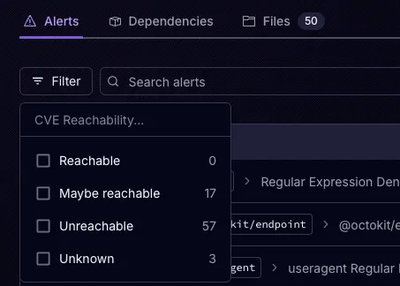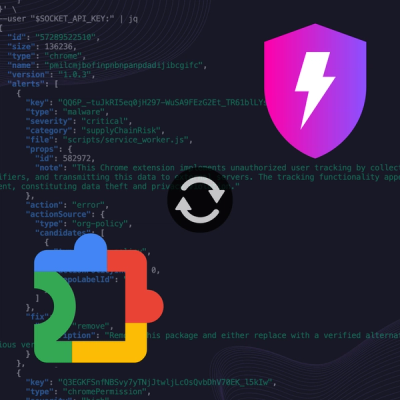
Product
Announcing Precomputed Reachability Analysis in Socket
Socket’s precomputed reachability slashes false positives by flagging up to 80% of vulnerabilities as irrelevant, with no setup and instant results.
django-sequential-pagination
Advanced tools
Paginate ordered Django querysets sequentially with "Next" button. Fully compatible with django-el-pagination_ (but doesn't depend on it).
The pagination is performed by object ID (or any other set of fields that give strict linear order) rather than by page number. Instead of ?page=2, ?page=3, etc., it produces links like ?from=11, ?from=21 and so on. This gives the following benefits:
The pagination works extremely fast even on huge data sets. For example, on Postgres "normal" pagination may take seconds (or even minutes) on queries like ?page=1000000.
It prevents duplicates on next page when new data is injected at top and shifts page boundaries (this is especially important for AJAX pagination).
The drawback is that there is no navigation to arbitrary page number and no reverse navigation, it's always only the link to "Next page" (or nothing at the last page).
.. _django-el-pagination: https://github.com/shtalinberg/django-el-pagination
::
pip install django-sequential-pagination
Add django_sequential_pagination to INSTALLED_APPS:
.. code:: python
# settings.py
INSTALLED_APPS = [
...
'django_sequential_pagination',
]
Pass an ordered queryset to the template:
.. code:: python
# views.py
def recent_posts(request):
return render(request, "blog/posts.html", {
'posts': Post.objects.all().order_by('-time', '-id'),
})
Make sure that the ordering always has a tie breaker as the last key, otherwise you may get duplicates on page boundaries.
Now, paginate objects in the template:
.. code:: django
{% load pagination %}
{% paginate posts per_page=10 as page %}
{% for post in page.objects %}
<div>Post #{{ post.id }}</div>
{% endfor %}
{% if page.next_page_url %}
<a href="{{ page.next_page_url }}">Next</a>
{% endif %}
You can override the default settings in your settings.py:
.. code:: python
SEQUENTIAL_PAGINATION_PER_PAGE = 20
SEQUENTIAL_PAGINATION_KEY = 'from' # querystring key to use, as in ?from=XXXX
You can enable endless pagination with django-el-pagination_ by putting this in the page template:
.. _django-el-pagination: https://github.com/shtalinberg/django-el-pagination
.. code:: django
{% paginate posts per_page=10 key='page' as page %}
{% for post in page.objects %}
<div>Post #{{ post.id }}</div>
{% endfor %}
{% if page.next_page_url %}
<nav class="endless_container">
<ul class="pagination"><!-- Bootstrap v3 styles -->
<li>
<a class="endless_more" href="{{ page.next_page_url }}" rel="{{ page.key }}">Show more</a>
</li>
</ul>
</nav>
{% endif %}
<script>
$.endlessPaginate({paginateOnScroll: true});
</script>
Make sure the pagination key (or SEQUENTIAL_PAGINATION_KEY) matches your AjaxListView.key. The defaults are different (from and page, respectively).
If Jinja2 is installed, django_sequential_pagination.templatetags.pagination will be a jinja2.contextfunction.
Additionally, if django_jinja_ is installed, it will be registered automatically as a global template function, so you can use it right away:
.. _django_jinja: https://github.com/niwinz/django-jinja
.. code:: jinja
{% set page = paginate(posts, per_page=10) %}
{% for post in page.objects %}
<div>Post #{{ post.id }}</div>
{% endfor %}
{% if page.next_page_url %}
<a href="{{ page.next_page_url }}">Next</a>
{% endif %}
FAQs
Fast sequential objects pagination for Django
We found that django-sequential-pagination demonstrated a healthy version release cadence and project activity because the last version was released less than a year ago. It has 1 open source maintainer collaborating on the project.
Did you know?

Socket for GitHub automatically highlights issues in each pull request and monitors the health of all your open source dependencies. Discover the contents of your packages and block harmful activity before you install or update your dependencies.

Product
Socket’s precomputed reachability slashes false positives by flagging up to 80% of vulnerabilities as irrelevant, with no setup and instant results.

Product
Socket is launching experimental protection for Chrome extensions, scanning for malware and risky permissions to prevent silent supply chain attacks.

Product
Add secure dependency scanning to Claude Desktop with Socket MCP, a one-click extension that keeps your coding conversations safe from malicious packages.